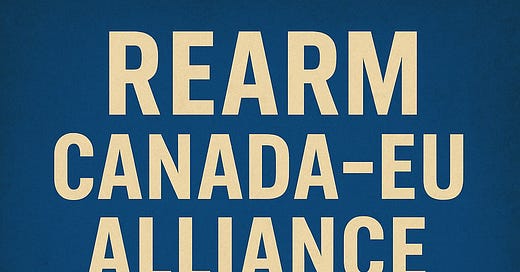Why Canada Joining Europe’s Rearmament Plan Is a Strategic Power Move
A Quiet Shift with Loud Implications: Canada Joins Europe’s War Prep
As leaders gather for this weekend’s G7 summit June 15- 17 in Kananaskis AB, and look ahead to NATO’s July 9-11 assembly in Washington, it’s clear the chessboard is shifting. Canada’s move into the EU’s rearmament strategy isn’t a side note—it’s central to where western alliances are heading.
When CBC aired a segment today on the EU’s historic rearmament plan and Canada’s unexpected involvement, it barely scratched the surface of what this means. To many, it might sound like Canada is just tagging along with European allies, a polite nod toward multilateralism. But this isn’t a symbolic move—it’s a seismic strategic alignment.
Let’s get one thing straight: this isn’t just about generosity, NATO optics, or being a "good partner." This is about Canada reclaiming its role as a key transatlantic actor—a builder, not just a backbencher.
If you’re not following the AP wires or European briefings, you’d be forgiven for missing where ‘meeting our NATO commitment’ is actually leading. This isn’t just a symbolic gesture—it’s a full pivot to war readiness not seen since WWII. The port-to-port-to-port infrastructure promised in the 2025 election? It not just about getting our oil to peacetime markets.
What Is the EU’s Rearmament Plan?
The EU’s new "ReArm Europe" initiative is a response to the hard lessons of the war in Ukraine and growing insecurity in the Indo-Pacific. It's a €800 billion (1.8 trillion CDN/860 billion USD) commitment to speed up arms manufacturing, diversify supply chains, and reduce dependency on U.S. defence infrastructure.
This is no small club. It’s an effort to reshape how Europe—and its trusted allies—prepare for and deter future conflicts.
And Canada just got its invitation.
Why Canada Matters More Than You Think
Canada is the first non-EU country being folded into this initiative. Not out of charity or historical debt—but because we bring things the EU urgently needs:
A secure North American logistics hub with deep NATO integration.
Defence manufacturing capacity free from U.S. domestic controls like ITAR.
Rare-earth minerals and AI/cyber expertise that plug holes in EU industry.
Political and diplomatic stability at a time when the U.S. is drifting toward transactional isolationism.
In short: we’re not just invited to the table—we’re helping to set it.
Canada’s NATO Obligations Are Driving This
This is where it gets interesting. Canada has long faced criticism for lagging behind NATO's 2% defence spending target. But this move flips the script. Instead of pouring more money into American-made systems, Canada is:
Investing in European aircraft and arms.
Co-developing defence infrastructure that supports allied needs.
Contributing to NATO readiness through capacity, not just cash.
This isn’t sidestepping responsibility. It’s redefining it. Canada is finally shaping how collective defence is built—not just writing the cheques, but signing off on the orders.
Energy & Resource Powerhouse
Canada brings more than troops and diplomacy—our natural resource portfolio is a strategic shield:
Rare-earth minerals: essential to modern weapons, radar, and missile systems, many of which Europe is scrambling to secure.
Hydroelectric and wind power: offer future-proofed energy partnerships as EU nations shift away from Russian gas.
Oil and gas: though controversial, still matter for EU winter security—especially via LNG partnerships.
Freshwater reserves: increasingly viewed as national security assets in a warming world, and a source of diplomatic leverage
This isn’t just about fossil fuel exports. It’s about energy security, manufacturing inputs, and global leverage. The EU sees Canada as more than a military ally—we're also a strategic resource bank with democratic stability.
What Happens If War Breaks Out?
If armed conflict erupts—be it in Europe, the Arctic, or the Pacific—Canada’s role is far from passive:
Our ports and airfields become NATO’s lifeline.
Our cyber units and Arctic surveillance assets plug critical security gaps.
Our industries support both European and domestic rearmament.
And perhaps most crucially: we become the bridge when transatlantic ties fray. With American politics volatile, the EU sees Canada as the stable voice in the room. We do what we did during WW2. Factories devoted to keeping the EU armed, food to feed a hungry continent, and much more.
Final Word
This isn’t Canada playing catch-up. It’s Canada leaning in. Our participation in the EU’s rearmament strategy is a bold signal that we understand what time it is geopolitically.
Not only are we meeting our NATO obligations—we're helping redefine what shared security looks like in the 21st century.
“We are not just buying into a defence strategy. We are co-building one.”
This is Part 1 of The Quiet Build-Up, a multi-part series on Canada’s evolving role in global defence and strategic alliances.
🟢 Want more context like this? Tap the 💚 or share this post with someone who thinks defence is just about budgets. It’s about power—and who gets to shape it. Leave a comment and let me know what you’d like to see me expand on in this series. -Leni







Brilliant! I hope Australia and New Zealand will also join the plan, so as to form a strong world spanning Democratic force.
Hippo Don will become irrelevant...
As an American, I wish success for Canada and the EU.